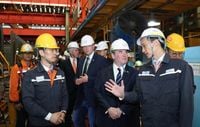In a significant move towards strengthening bilateral ties in the shipbuilding sector, John P. Roth, the U.S. Secretary of the Navy, visited South Korea on April 30, 2025, to explore cooperation opportunities with local shipbuilding giants. Roth's itinerary included visits to the headquarters of HD Hyundai in Ulsan and Hanwha Ocean in Geoje, where he engaged with key executives and inspected advanced shipbuilding technologies.
During his visit to Ulsan, Roth met with Jeong Ki-seon, Vice Chairman of HD Hyundai, discussing the potential for collaboration between the U.S. and South Korea in shipbuilding. Roth boarded the ROKS Mado, a minesweeper constructed by HD Hyundai, and examined the next-generation Aegis destroyer, Jeongjo Daewangham, which is set to launch by the end of this year. At HD Hyundai's integrated digital control center, Roth closely observed the company's smart shipyard and achievements in digital transformation.
Jeong emphasized the deep-rooted alliance between the two nations, stating, "South Korea and the United States are the best allies bound by blood," and pledged that HD Hyundai would contribute to the revitalization of the U.S. shipbuilding industry with its advanced capabilities.
Roth's guestbook entry included the phrase 'Bravo Zulu,' a naval term recognizing successful operations, while Jeong wrote, "We will build the U.S. shipbuilding industrial base together." Following his engagements in Ulsan, Roth traveled to Geoje to meet with Kim Dong-kwan, Vice Chairman of Hanwha Group, where discussions focused on shipbuilding cooperation.
At Hanwha Ocean, Roth inspected the 'Yukon,' a supply ship of the U.S. Navy's 7th Fleet undergoing maintenance, repair, and overhaul (MRO) operations. He also reviewed key production areas, including submarine construction zones, and noted the automation processes in ship block assembly. Roth's remarks in the guestbook included 'Awesome shipyard' alongside 'Bravo Zulu.'
Kim highlighted Hanwha Ocean's readiness to meet the U.S. Navy's strategic needs, stating, "We have completed a construction system that can respond quickly to the strategic needs of the U.S. Navy in any situation." He also noted that Hanwha Ocean was the first Korean company to acquire a U.S. shipyard and has successfully completed MRO projects for the U.S. Navy.
The discussions culminated in a 'Brown Bag Meeting,' where both sides shared a meal of Korean dishes, including bulgogi, while continuing to explore avenues for collaboration.
In a broader context, the Korea International Trade Association (KITA) has released a report underscoring the potential for South Korea's shipbuilding industry to leverage U.S. initiatives aimed at protecting domestic shipbuilding and imposing tariffs on Chinese vessels. The report indicates that South Korea has maintained the second-highest order volume in the global shipbuilding market for six consecutive years, with a 2024 order share of 16.7%, significantly lower than China's 70.6% but higher than Japan's 4.9%.
Recent U.S. policies, including the reintroduction of the 'SHIPS for America Act' by bipartisan lawmakers, aim to stimulate shipbuilding investments through tax incentives and establish a fleet of 250 U.S.-flagged vessels within the next decade. This legislation could open new opportunities for South Korea's shipbuilders, particularly as it includes provisions that allow foreign-built ships to be considered as U.S.-constructed vessels.
Furthermore, the Wall Street Journal reported that Hanwha Ocean's acquisition of the Philadelphia shipyard could lead to increased order volumes. KITA suggests that the three primary areas for cooperation between the U.S. and South Korea in shipbuilding are MRO, LNG carriers, and naval vessel construction.
As of November 2024, the U.S. Navy operates 149 major warships, with an annual budget of approximately $6 billion to $7.4 billion allocated for MRO. South Korean firms like Hyundai Heavy Industries and Hanwha Ocean have signed Maintenance, Repair, and Overhaul (MSRA) agreements with the U.S. Navy, positioning themselves as key players in this market.
Despite the promising outlook, challenges remain, including labor shortages and outdated infrastructure in the U.S. shipbuilding industry. Analysts caution that while the current political climate may favor South Korean shipbuilders, the U.S. protectionist sentiment and potential political backlash could complicate future collaborations.
The shipbuilding industry in South Korea has shown resilience, with HD Hyundai, Hanwha Ocean, and Samsung Heavy Industries reporting strong earnings in the first quarter of 2025. HD Hyundai recorded sales of 6.77 trillion won and an operating profit of 859.2 billion won, marking a significant increase from the previous year. Hanwha Ocean's performance was similarly impressive, with sales of 3.14 trillion won and an operating profit of 258.6 billion won, exceeding market expectations.
Industry experts believe that this could be a pivotal moment for South Korea's shipbuilding sector, as it seeks to widen the technological gap with China. The U.S. Navy's anticipated investments of approximately $300 billion annually until 2054 for new warship construction further underscore the potential for South Korean firms to play a crucial role in meeting these demands.
However, analysts also warn of the need to remain vigilant against the rise of U.S. protectionism, which could hinder the growth of South Korea's shipbuilding industry. As the U.S. seeks to bolster its own shipbuilding capabilities, South Korea must navigate these challenges while capitalizing on the opportunities presented by the evolving geopolitical landscape.
In conclusion, the collaboration between South Korea and the U.S. in shipbuilding not only promises to enhance military capabilities but also holds the potential for significant economic benefits for both nations. As both sides continue to explore avenues for cooperation, the future of the shipbuilding industry in South Korea appears promising, albeit with challenges that require careful navigation.




